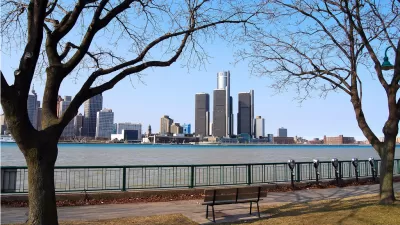Detroit native Pete Saunders makes the case that poor planning put the nail in Motown's casket.
For all the discussion and analysis focused around Detroit's meteoric rise and fall, the most widely accepted assessment – that a confluence of racial tension, vanishing industry, and political corruption caused the city to collapse from within – still misses the mark of this cautionary tale. As Saunders explains, a number of other cities (Buffalo, Cleveland, Chicago, and Pittsburgh, to name a few) faced similar challenges and emerged on the other side in much better shape. So what went wrong?
The problem, Saunders claims, is that leaders in the Automotive Capital of the World left the helm of "sound urban planning and design" in favor of growing its industry, and "let the booming economy to do the work for them." Without an effective, attractive built environment, the problems that so many cities faced in the 20th century became insurmountable.
Saunders enumerates the key problems in Detroit's planning heritage:
1) Poorly defined neighborhoods
2) Outdated housing stock
3) A visually barren public realm
4) A weak downtown
5) Freeway expansion
6) Transit neglect
7) City-wide local elections (rather than by-ward)
8) An industrial landscape that limited growth
9) Untimely annexation
Any effort to revitalize the city that does not first address these problems rests on shaky foundations.
FULL STORY: The Reasons behind Detroit's Decline

Planetizen Federal Action Tracker
A weekly monitor of how Trump’s orders and actions are impacting planners and planning in America.

Maui's Vacation Rental Debate Turns Ugly
Verbal attacks, misinformation campaigns and fistfights plague a high-stakes debate to convert thousands of vacation rentals into long-term housing.

San Francisco Suspends Traffic Calming Amidst Record Deaths
Citing “a challenging fiscal landscape,” the city will cease the program on the heels of 42 traffic deaths, including 24 pedestrians.

Amtrak Rolls Out New Orleans to Alabama “Mardi Gras” Train
The new service will operate morning and evening departures between Mobile and New Orleans.

The Subversive Car-Free Guide to Trump's Great American Road Trip
Car-free ways to access Chicagoland’s best tourist attractions.

San Antonio and Austin are Fusing Into one Massive Megaregion
The region spanning the two central Texas cities is growing fast, posing challenges for local infrastructure and water supplies.
Urban Design for Planners 1: Software Tools
This six-course series explores essential urban design concepts using open source software and equips planners with the tools they need to participate fully in the urban design process.
Planning for Universal Design
Learn the tools for implementing Universal Design in planning regulations.
Heyer Gruel & Associates PA
JM Goldson LLC
Custer County Colorado
City of Camden Redevelopment Agency
City of Astoria
Transportation Research & Education Center (TREC) at Portland State University
Jefferson Parish Government
Camden Redevelopment Agency
City of Claremont





























